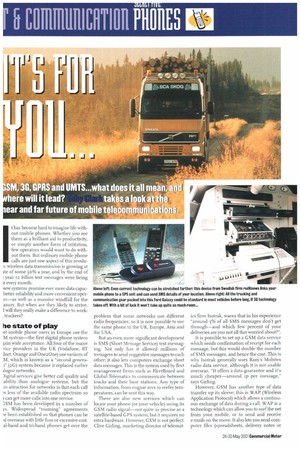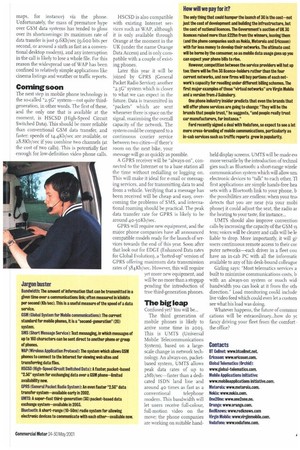SM 301, GPRS and UMTS...what does it all rni, III I
Page 40

Page 41

If you've noticed an error in this article please click here to report it so we can fix it.
here will it lead? takes a loo ( 'ON ear and far future of mobile telecomm Ill 1) 11:3 It has become hard to imagine life without mobile phones. Whether you see them as a brilliant aid to productivity, or simply another form of irritation, few operators would want to do without them. But ordinary mobile phone calls are just one aspect of this revolua: wireless data transmission is growing at rte of some 50% a year, and by the end of t year 12 billion, text messages were being it every month.
■ Iew systems promise ever more data capacbetter reliability and more convenient oper)n—as well as a massive windfall for the asury. But when are they likely to arrive, I will they really make a difference to worktruckers?
he state of play
rst mobile phone users in Europe use the M system—the first digital phone system lain wide acceptance. All four of the major vice providers in the UK (Vodafone, BT filet, Orange and One2One) use variants of M, which is known as a "second generaa" (2G) system because it replaced earlier ilogue networks.
)igital services give better call quality and ability than analogue systems, but the in attraction for networks is that each call !s less of the available radio spectrum so can get more calls into one service.
3SM has been developed in a number of ys. Widespread "roaming" agreements re been established so that phones can be tcl overseas with little fuss or excessive cost. al-band and tri-band phones get over the problem that some networks use different radio frequencies, so it is now possible to use the same phone in the UK, Europe, Asia and the USA.
But an even more significant development is SMS (Short Message Service) text messaging. Not only has it allowed millions of teenagers to send suggestive messages to each other; it also lets computers exchange short data messages. This is the system used by fleet management firms such as FleetBoard and Global Telernatics to communicate between trucks and their base stations. Any type of information, from engine revs to reefer temperatures, can be sent this way.
There are also new services which can locate your phone (or your vehicle) using its GSM radio signal—not quite as precise as a satellite-based G PS system, but it requires no extra hardware. However, GSM is not perfect: Clive Girling, marketing director of telemat
ics firm Isotrak, warns that in his experience "around 5c/D of all SMS messages don't get through—and which few percent of your deliveries are you not all that worried about?".
It is possible to set up a GSM data service which sends confirmation of receipt for each message, but this would double the number of SMS messages, and hence the cost. This is why Isotrak generally uses Ram's Mobitex radio data service, although it is not usable overseas. "It offers a data guarantee and it's much cheaper—around ip per message," says Girling.
However, GSM has another type of data transfer up its sleeve: this is WAP (Wireless Application Protocol) which allows a continuous exchange of data during a call. WAP is a technology which can allow you to surfthe net from your mobile, or to send and receive e-mails on the move. It also lets you send computer files (spreadsheets, delivery notes or maps, for instance) via the phone. Unfortunately, the mass of premature hype over GSM data systems has tended to gloss over its shortcomings: its maximum rate of data transfer is just 9.6Kb/sec (9,600 bits per second, or around a sixth as fast as a conventional desktop modem), and any interruption in the call is likely to lose a whole file. For this reason the widespread use of WAP has been confined to relatively simple applications like cinema listings and weather or traffic reports.
Coming soon
The next step in mobile phone technology is the so-called "2.5G" system—not quite thirdgeneration, in other words. The first of these, and the only one that is available at the moment, is HSCSD (High-Speed Circuit Switched Data). This should be more reliable than conventional GSM data transfer, and faster: speeds of 14.4Kb/sec are available, or 28.8Kb/sec if you combine two channels (at the cost of two calls). This is potentially fast enough for low-definition video phone calls. HSCSD is also compatible with existing Internet services such as WAP, although it is only available through Orange at the moment in the UK (under the name Orange Data Access) and is only compatible with a couple of existing phones.
Later this year it will be joined by GPRS (General Packet Radio Service): another "2.5G" system which is closer to what we can expect in the future. Data is transmitted in "packets" which are sent whenever there is space on the signal, maximising the overall capacity of the network. The system could be compared to a continuous courier service between two cities—if there's room on the next bike, your message will go as quickly as possible.
A GPRS receiver will be "always-on", connected to the Internet or to a base station all the time without redialling or logging on. This will make it ideal for e-mail or messaging services, and for transmitting data to and from a vehicle. Verifying that a message has been received will be cheap and easy, overcoming the problems of SMS, and international roaming should be practical. The peak data transfer rate for GPRS is likely to be around 40-50 Kb/sec.
GP RS will require new equipment, and the major phone companies have all announced compatible models ready for the launch of services towards the end of this year. Soon after that look out for EDGE (Enhanced Data rates for Global Evolution), a "hotted-up" version of GP RS offering maximum data transmission rates of 384Kb/sec. However, this will require yet more new equipment, and will be no more than a stopgap pending the introduction of true third-generation phones.
The big leap
Confused yet? You will be...
The third generation of mobile phones is likely to arrive some time in 2003. This is UMTS (Universal Mobile Telecommunications System), based on a largescale change in network technology. An always-on, packetbased system, UMTS allows peak data rates of up to 2Mb/sec—faster than a dedicated ISDN land line and around 40 times as fast as a
conventional telephone modem. This bandwidth will let users receive full-colour, full-motion video on the move; the phone companies are workiri on suitable hand held display screens. UMTS will be made ev( more versatile by the introduction of technol gies such as Bluetooth: a short-range wirele communication system which will allow smi electronic devices to "talk" to each other. TI first applications are simple hands-free hea sets with a Bluetooth link to your phone, b the possibilities are endless: when your trui detects that you are near (via your mobi phone) it could adjust the seat, the radio ar the heating to your taste, for instance...
UMTS should also improve convention calls by increasing the capacity of the GSM s) tern; voices will be clearer and calls will be le liable to drop. More importantly, it will users continuous remote access to their cor puter networks—each driver in a fleet cou have an in-cab PC with all the informatic available to any of his desk-bound colleague
Girling says: "Most telematics services a built to minimise communications costs, b. with an always-on system or much wid. bandwidth you can look at it from the oth. direction." Load monitoring could include live video feed which could even let a custom. see what his load was doing.
Whatever happens, the future of commur cations will be extraordinary...how do yc fancy driving your fleet from the comfort . the office?




























































































































